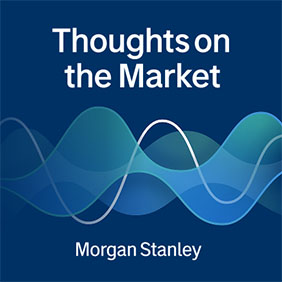An M&A Boom for Financials
October 13, 2025
Morgan Stanley analysts Betsy Graseck and Michael Cyprys discuss what’s driving unprecedented consolidation for asset and wealth management firms.

Thoughts on the Market
Listen to our financial podcast, featuring perspectives from leaders within Morgan Stanley and their perspectives on the forces shaping markets today.

Up Next
An Unprecedented Wave of Inheritances Is Coming
Transcript
Michelle Weaver: Welcome to Thoughts on the Market. I'm Michelle Weaver, Morgan Stanley's U.S. Thematic and Equity Strategist.
Today, a powerful force reshaping the financial lives of millions of Americans: inheritance.
It's Friday, October 10th at 10am in New York.
Americans are living longer and they're passing on their wealth later. Longevity is one of Morgan Stanley Research's four key themes, and this is an interesting element of longevity. As baby boomers age, they're expected to transfer their wealth to Gen X, millennials and Gen Z to the tune of tens or even hundreds of trillions of U.S. dollars.
Estimates vary widely, but the amounts are unprecedented. And so, inheritance isn't just a family milestone. It's becoming an important cornerstone of financial planning and longevity. And understanding who's receiving, expecting, and using their inheritances is key to forecasting how Americans save, spend, and invest.
According to our latest, AlphaWise survey, 17 percent of U.S. consumers have received an inheritance, and another 14 percent expect to receive one in the future. Younger Americans are especially optimistic. Their expectations split evenly between those anticipating an inheritance within the next 10 years and those expecting it further out.
But here's the kicker; income plays a huge role. Only 17 percent of lower income consumers report receiving or expecting an inheritance, but that number jumps to 43 percent among higher income households highlighting a clear wealth divide.
What about the size of the inheritance? In our survey, those who received or expect to receive an inheritance fall broadly into three categories. About half reported amounts under $100,000 dollars. For about a third, that amount rose to under $500,000. And then meanwhile, 10 per cent reported an inheritance of half a million dollars or more.
Younger consumers tend to report smaller amounts, while inheritance size rises with income. One important thing to remember about our survey though, is it looks more at the average person. We are missing some of those very high net worth demographics in there where I would expect inheritance to rise much higher than half a million.
And so, when we think about this, how will recipients use this wealth? That's a really important question. The majority, about 60 percent, say they have or will put their inheritance towards savings, retirement, or investments. About a third say they'll use it for housing or paying down debt. Day-to-day consumption, travel, education and even starting a business or giving to charity also featured in the survey responses – but to a lesser extent.
The financial impact of inheritance is significant: 46 percent of recipients say it makes them feel more financially secure; 40 percent cite improvements in savings and; 22 percent associate it with increased spending. Some even report retiring earlier or lightening their workloads.
Inheritance trends are shaping consumer behavior and have the power to influence spending patterns across industries. To sum it up, inheritance isn't just a family matter, it's a market mover.
Thanks for listening. If you enjoy the show, please leave us a review wherever you listen, and share Thoughts on the Market with a friend or colleague today.

Lessons From a Bond Issued 90 Years Ago
Transcript
Andrew Sheets: Welcome to Thoughts on the Market. I'm Andrew Sheets, Head of Corporate Credit Research at Morgan Stanley.
Today, a look at the first bond that Morgan Stanley helped issue 90 years ago and what it might tell us about market uncertainty.
It's Thursday, October 9th at 4pm in London.
In times of uncertainty, it's common to turn to history. And this we think also applies to financial markets. The Great Depression began roughly 95 years ago. Of its many causes, one was that the same banks that were shepherding customer deposits were also involved in much riskier and more volatile financial market activity.
And so, when the stock market crashed, falling over 40 percent in 1929, and ultimately 86 percent from a peak to a trough in 1932, unsuspecting depositors often found their banks overwhelmed by this market maelstrom.
The Roosevelt administration took office in March of 1933 and set about trying to pick up the pieces. Many core aspects that we associate with modern financial life from FDIC insurance to social security to the somewhat unique American 30-year mortgage rose directly out of policies from this administration and the financial ashes of this period.
There was also quite understandably, a desire to make banking safer. And so the Glass Steagall Act mandated that banks had a choice. They could either do the traditional deposit taking and lending, or they could be active in financial market trading and underwriting. In response to these new separations, Morgan Stanley was founded 90 years ago in 1935 to do the latter.
It was a very uncertain time. The U.S. economy was starting to recover under President Roosevelt's New Deal policies, but unemployment was still over 17 percent. Europe's economy was struggling, and the start of the Second World War would be only four years away. The S&P Composite Equity Index, which currently sits at a level of around 6,700, was at 12.
It was into this world that Morgan Stanley brought its first bond deal, a 30-year corporate bond for a AA rated U.S. utility. And so, listeners, what do you think that that sort of bond yielded all those years ago?
Luckily for us, the good people at the Federal Reserve Bank of St. Louis digitized a vast array of old financial newspapers. And so, we can see what the original bond yielded in the announcement. The first bond, Morgan Stanley helped issue with a 30-year maturity and a AA rating had a yield of just 3.55 percent. That was just 70 basis points over what a comparable U.S. treasury bond offered at the time.
Anniversaries are nice to celebrate, but we think this example has some lessons for the modern day. Above anything, it's a clear data point that even in very uncertain economic times, high quality corporate bonds can trade at very low spreads – much lower than one might intuitively expect.
Indeed, the extra spread over government bonds that investors required for a 30-year AA rated utility bond 90 years ago, in the immediate aftermath of the Great Depression is almost exactly the same as today.
It's one more reason why we think we have to be quite judicious about turning too negative on corporate credit too early, even if the headline spreads look low.
Thank you as always for your time. If you find Thoughts on the Market useful, let us know by leaving a review wherever you listen. And also, please tell a friend or colleague about us today.

Sign up to get Morgan Stanley Ideas delivered to your inbox.
Thank You for Subscribing!
Would you like to help us improve our coverage of topics that might interest you? Tell us about yourself.



